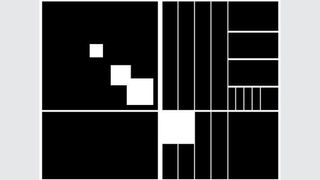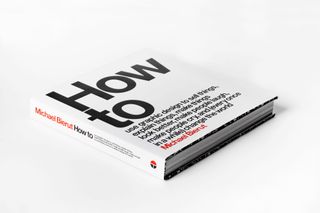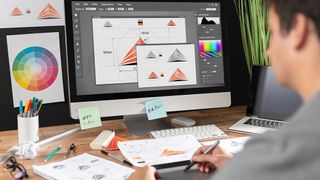
Improving your graphic design skills should be a constant goal. As in any profession, it's always possible to improve, but also the technology, techniques and approaches are changing all the time, and it's important to keep on top of development to avoid being left behind.
As a graphic designer, it's quite easy to stagnate, especially if you become known for a particular style or niche that you really excel at. Very quickly you can develop an identifiable style, and your portfolio starts to look somewhat all the same. There are things to be said for that if it's a style that customers are looking for, but trends tend to come and go and the danger is that at some point demand for that style will dry up and you'll be left with a portfolio that fails to show a wide enough variety of work to win other clients.
So how can break out of the mould and improve your graphic design skills? Here are six practical, achievable ways to continually improve your graphic design skills. Of course. Looking for more advice to further your design career? Make sure you also see our guide to how to start a design business, our tips for the perfect résumé for creatives, and our roundup of the best business card templates.
01. Study design theory

If you've got this far, then you already know that graphic design skills involve a lot more than simply putting elements together and seeing what looks nice. All the same, it can always be useful to go back to the theory – and they're almost always more to learn. Graphic design is a profession, and while there is plenty you can learn by doing, and lots of opportunities to enter the industry without having a degree, a proper, deep understanding of the fundamentals is the first step to improving graphic design skills.
These fundamentals include concepts such as grid theory, colour theory, typography and the golden ratio. For many designers, a formal design education really shows its value here. There are plenty of options, from full university degrees to focused short courses to distance learning setups, and if you're strapped for cash there are even some decent free graphic design courses. And if you're not able to commit to formal study, our selection of the best graphic design books can also help you gain more knowledge.
02. Get the most from feedback

Feedback is essential for a graphic designer, and yet dealing with criticism is also one of the most emotionally draining parts of the job. It can be all too easy to cast feedback aside and to assume at the client doesn't know what they're talking about (which can certainly be the case, but remember that they're the customer). How you deal with feedback is a skill that's just as important – perhaps even more important than you're actual design skills. It can make a difference to how long projects take, and to whether a customer comes back to you.
Listening to feedback can really improve your graphic design skills, especially when it's negative, or shall we say constructive criticism. It can make you more sensitive to smaller details that you might initially have overlooked and improve your ability to see things from different viewpoints and interpretations. This doesn't only apply to feedback from clients. Feedback from colleagues or even the larger community via social media or platforms like Dribbble and Behance can help you open up to different perspectives.
One key to getting the most useful feedback is to consider how you ask for it. Instead of asking a colleague 'What do you think?’ (probably answer: ‘It’s great’), ask specific questions, for example, 'This is the brief, do you think I’ve fulfilled it?' or 'Which part of the design did your eye focus on first?' That way people will be able to critique your work in a constructive way, without coming off like a boorish troll.
It can also be useful for you to give your own feedback on other designers’ work too. This can help you to empathise and improve the way you critique work in order to then apply that to your own projects.
03. Start a side project

If you're designing the same kind of pieces over and over again in your nine-to-five job, that can quickly lead to your graphic design skills becoming stale, not to mention the impact on your own enthusiasm and passion for the discipline. One way to keep up your drive to learn new things is by starting your own side project.
Learning a new design skill is always far easier if you need it to create a specific thing, particularly if that’s something personal to you. So a personal project can lead you to learn new skills you’d never even thought of, without needing the kind of self-discipline associated with formal study.
04. Experiment

There's a popular saying in the world of web startups: fail fast. In other words. it’s only by trying out lots of experimental design ideas and putting them into practice that you find out what works best and what you’re good at. It’s an approach that graphic designers can learn from when it comes to experimenting with new media, skills and techniques (see our selection of experimental design projects) in order to avoid getting stuck in a rut.
Rather than always using the same fonts, colours, layouts or software for every design you tackle, mix things up a bit and try something new. Throw in a crazy new typeface. Try 3D rather than 2D. Sketch with a ballpoint pen or charcoal rather than a pencil. Break a rule and see what happens. Ask yourself: how would this design have been approached in a bygone age? Use illustration not photography. Double the amount of whitespace. In short, throw convention up in the air and see what lands.
Most of the time, what lands will be an unusable mess. But just occasionally, you’ll hit gold. And even if you don’t, the very process of experimenting will help free up your mind, to better see which of your creative skills need improving, and why.
05. Talk to other designers

One of the best ways to develop as a designer is to interact with a lot of other designers. But sometimes that can be difficult. You might be the only designer in a big company, a freelancer who works from home alone, or perhaps you’re employed by a two- or three-person studio.
But really, these are all just excuses. There are many easy ways to get out there and chat with other creatives.
Go to meetups, events and conferences. Hit people up on social media. Check out forums. Make friends. Talk design. Discuss problems, challenges, questions. Collaborate on a project. Email a designer you admire. Ask them to be your mentor. Appear on their podcast, or start your own so you can interview your heroes.
In short, force yourself to just get out there. You’ll meet some fascinating people, and learn more than you could possibly imagine.
06. Read a book

The first tip on our list of ideas for how to improve your design skills was to brush up on your theory. That will often mean formal study, but you can also build your knowledge through literature. There's a huge range of books on the topics of graphic design theory, graphic design skills and how to succeed in the industry, and these can provide inspiring insights not only into theoretical aspects but also from the real experience of successful designers.
Next time you have a long train journey, put your phone on silent and settle down with a good book on graphic design. It will certainly be a better use of your time than snarling at trolls on Twitter or looking at food pics on Instagram. There are hundreds of informative and inspiring reads to explore, but our bumper list of the best graphic design books is a good place to start.
07. Try changing your software

One of the milestone moments in the development of a lot of designers' graphic design skills comes when they upgrade their software. The program you use for your design can make a big difference to your workflow and to what possibilities you have. Every software, no matter how intuitive, involves something of a learning curve, but even if you're already using industry-standard software, you might find that another program opens up new ideas. See our picks of the best graphic design software and the best digital art software for suggestions. You might also want to make sure you have one of the most powerful laptops or one of the best laptops for graphic design.
Read more

Thank you for reading 5 articles this month* Join now for unlimited access
Enjoy your first month for just £1 / $1 / €1
*Read 5 free articles per month without a subscription

Join now for unlimited access
Try first month for just £1 / $1 / €1
Get the Creative Bloq Newsletter
Daily design news, reviews, how-tos and more, as picked by the editors.
Tom May is an award-winning journalist and editor specialising in design, photography and technology. Author of the Amazon #1 bestseller Great TED Talks: Creativity, published by Pavilion Books, Tom was previously editor of Professional Photography magazine, associate editor at Creative Bloq, and deputy editor at net magazine. Today, he is a regular contributor to Creative Bloq and its sister sites Digital Camera World, T3.com and Tech Radar. He also writes for Creative Boom and works on content marketing projects.
